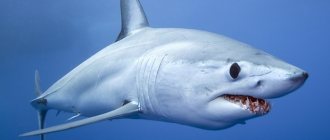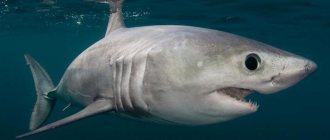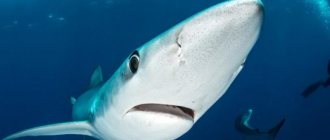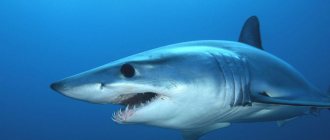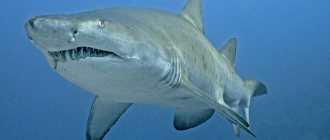Sharks have been around for a long time, they appeared approximately 420-450 million years ago. Many legends have arisen around these predators. They are considered the thunderstorm of the seas and the most dangerous creatures both for other underwater inhabitants and for humans. Some consider sea killers to be mammals, but the predator does not suckle its young, so the shark is a fish.
Shark (the most dangerous predator) is actually a fish
What does a shark look like - general characteristics
Sharks, whose diversity on Earth exceeds 500 species, belong to the cartilaginous elasmobranch class of vertebrate fish.
In no case should they be considered mammals, like dolphins or whales; this predator is a fish.
Most species of this predatory fish are characterized by general external characteristics:
- an oblong body, similar to a torpedo, tapering towards the mouth (rostrum) and towards the tail, which ends with a heterocercal fin;
- lateral lamellar gills resembling slits, with 5 to 7 slits on each side;
- huge black-matte eyes, behind which there are openings entering the throat, called splashes.
Sea hunters can boast of a variety of skin colors (white, gray, blue, spotted, striped), depending on the species to which they belong.
4.White shark (Carcharodon carcharias)
Among other species, the white shark is the most ferocious. Such a monster does not disdain humans; more than half of the attacks are carried out by this shark. The average size is 4.5-5 m. There are specimens more than 6 m in length and weighing at least 1900 kg. This fish will also be the fastest of the other sharks. She attacks a person out of curiosity. Lives in all oceans except the Arctic. It is an endangered species; there are only 3.5 thousand of these sharks in the world. Its food consists of small and medium-sized fish, turtles, sea lions, seals, and toothed whales.
External and internal structure of a shark
Most of them have a streamlined, rounded body shape, with an elongated and narrowed front part and head - all this significantly helps to reach speeds of up to 80 km/h.
However, there are external differences among sharks
, such as:
- A hammerhead fish whose head is precisely shaped like a compressed hammer. On the T-shaped head, next to the nostrils on the sides, there are eyes that have binocular vision.
- “Sea angels” - due to their flat body, they look like stingrays and live on the bottom.
- Carpet sharks, like angelfish, are adapted to live on the bottom. On the sides of the head there are outgrowths that resemble fringes and help to camouflage well in algae thickets.
They differ from each other in size: some reach 20 meters in length, while others, the smallest, have a body length of only 17 centimeters.
Shark scales
In phylogenetics, the shark is considered the most ancient representative among fish due to the structure of its skin. Consisting of durable diamond-shaped plates with spikes that fit tightly together, the skin appears very smooth.
Such a durable placoid scaly covering of the skin protects it well from attacks by other animals and from parasites, but still fetters movement, like chain mail.
Throughout its long evolutionary period, the skeleton has not undergone any changes, but has completely lost bones, which have replaced cartilaginous connective tissue.
Modern sharks have a skeleton and skull made of cartilaginous tissue.
Its skeletal axis, like everyone else’s, is the spine, consisting of cartilaginous amphicoelous vertebrae. The shark skull is divided into two sections: the oral skeleton with gill apparatus and the cranium. Its body is equipped with separate fins located in the tail and back areas, and paired fins in the chest and abdominal areas.
The muscular system of these predators is responsible for the continuous functioning of the heart, for the arteries and internal organs, and for movement itself, whose muscular functionality is divided into bundles of individual muscles.
Since there is no swim bladder in a shark carcass, the fins, spine and large liver are responsible for its buoyancy.
7. Hammerhead shark (Sphyrna mokarran)
The hammerhead shark (hammerhead fish) is one of the most amazing and unusual fish in the world. Inhabits continental shelves and coastal zones of tropical waters, sometimes found in open water. So called for its head in the shape of a hammer. It is rightfully one of the largest sharks in the world for its size: depending on the species, it can be up to 6 m in length and weighing about 600 kg. Its bizarre head and graceful fins make it stand out from its other relatives. The shark has a ferocious temperament, but rarely attacks people. In the hunting process, the head of the fish plays a decisive role, because “sensors” run along its front edge that capture the smell and electric field of the prey, and the position of the eyes creates a 360-degree vertical view. There are sharks with the largest heads - a third of the body size. It feeds on shrimp, shellfish, crabs, squid, fish, but most of all the predator likes stingrays and flounder.
How many teeth does a shark have
The shark's jaw is located extremely inconveniently for fish. In order to grab onto the victim, she has to bend to the side or even roll over onto her back, but this does not reassure her victim at all.
The jaw, with numerous rows of sharp and jagged teeth at the edges, easily bites into the flesh, giving no chance of escape.
The number of teeth and rows varies depending on the species of fish. In some, the number of rows reaches 50, and the total number of teeth reaches 1.5 thousand, like a reef shark. The largemouth shark has up to 10 thousand teeth per 22 rows.
Lost teeth are not a big problem for this predator, since they are replaced by teeth from other rows, representing a kind of conveyor belt.
Megalodon
What's a hit collection without surprises? Many a question: what does another species have to do with this if we have already decided on the first position? In fact, the whale fish is indeed the largest in size. But - in modern realities. Among the extinct species, another fish is in the lead.
The megalodon shark is the undisputed record holder of those distant times and species. Unfortunately, the largest shark was not included in the video - the fossil fish disappeared long before the development of our technologies. According to scientists, the size of the mega-fish was in the range of 12-18 m. At the same time, the largest shark in the world, megalodon, was heavier than a modern whale - about 50 tons. Due to its size, the shark even fed on similar, but smaller, species.
Where are sharks found?
Numerous species of predatory fish live in all oceans and seas, but not all of them are so dangerous to humans.
Shark habitats
For example, the bearded shark is found in the Indian Ocean, the whale shark can be found throughout the World Ocean, the giant shark prefers seas with temperate or cool waters.
But some of the dangerous predators are often observed in crowded places: off the sandy beaches of Africa, Florida, California, off the Hawaiian Islands, resorts in Egypt, Southern Primorye (Russia), off the coast of Australia.
There are also freshwater predators that live in the lake water of Nicaragua, and are also capable of living in both salty and fresh waters (common gray and blunt-nosed sharks).
10.Mako shark (Isurus oxyrinchus)
The mako shark or blue-gray herring shark ranks last among the ten largest sharks in the world, but is far from the last in terms of agility and intellectual development. It has an average body size of 3-3.5 m (maximum length 4.45 m) and a weight of 554 kg. Rushing at the victim, it reaches a speed of 74 km per hour. In the world it is found in almost all seas and oceans. The mako shark is of great interest to sport fishing enthusiasts. The meat of these unique sharks is also highly prized. Due to fishing, their population is under serious threat. Due to their aggressive nature, excellent maneuverability and large size, mako sharks pose a mortal danger to people. When chasing its prey, a shark is capable of jumping out of the water to a height of up to 6 m.
What do sharks eat?
Some of the representatives of sea hunters feed on plankton and small inhabitants of the bottom, but, basically, this is an omnivorous predator that attacks whales, dolphins, fur seals, humans and its own relatives, and does not disdain cans, iron, plastic and other garbage.
The lack of disgust for a variety of food, even dead ones, allowed this predator to survive centuries of competition with other representatives of the aquatic world.
1.Whale shark (Rhincodon typus)
The prize place is taken by the largest shark in the world - the whale shark . It grows more than 12 m in length and can weigh more than 21 tons! In 2002, Chinese fishermen caught a shark measuring 20 m and weighing 34 tons. It inhabits open, warm oceans. Eats plankton and small and medium-sized fish. The fish population is quite large and they are not in danger of extinction, but they are listed in the International Red Book due to large catches. Fins and other parts of a shark’s body are very expensive, which is why poachers hunt for it. Every day the shark eats 200 kg of fish and zooplankton. It reproduces by ovoviviparity, and newborn cubs are about half a meter in length. He poses no danger to a person; rather, he is to her.
Shark breeding
Sharks, like cartilaginous fish, have a common process of internal fertilization. The developed fetus in the uterus is independent after birth and is adapted to fight for its survival.
In cubs, the entire body with the digestive system, musculoskeletal system and sensory organs is fully developed, which contributes to rapid growth.
These predators are divided into viviparous, ovoviviparous, and oviparous.
Viviparous individuals give birth to from 20 to 40 cubs, which, while still in the womb, turn out to be dangerous predators, eating their own, which is why only one can be born.
Shark egg capsules
Ovoviviparous and oviparous animals give birth from 1 to 12 individuals, and the polar shark alone can produce up to 500 pups.
The exact period of gestation is not known; approximately 11 months to 2 years have been recorded.
3.Greenland polar shark (Somniosus microcephalus)
The Greenland polar shark belongs to the order Katraniformes and is distributed in the north of the Atlantic Ocean. Also found in the waters of Iceland, Greenland, Norway, the Barents Sea in Russia and coastal areas of Mexico and Japan. This giant is one of the three largest shark species in the world. Adult animals can reach 6.4 m in length and weigh a ton! Ichthyologists believe that the Atlantic shark can reach large sizes. The color of the body is brown or dark brown, with small scales. She leads a sedentary lifestyle, has a melancholic character, and is the slowest shark on Earth (maximum speed 2.7 km/h). During the hunt, it chooses a wait-and-see position and lies in wait for the sleeping prey. Metabolic processes in the body of this shark proceed very slowly, so they live for a long time. In 2010-13 Scientists did carbon dating of the lens of the eyes of several polar sharks, as a result of which they found that the age of the longest of the tested individuals was in the range of 272-512 years. There is nothing surprising here, because females of this species of large shark reach sexual maturity at 150 years of age.
Types of sharks - photos and brief description of the species
Since there are over 500 species of sharks, differing from each other in their modes of birth, habitat, food preferences, behavior and external differences, each of them has a specific class and name.
Some of these representatives prefer expanses of water and the depths of the sea, while others like to scurry along the coast. Some of them may be indifferent to a person unless he himself shows disrespect for the predator, while others purposefully seek a meeting with him.
Let's look at some of the elasmobranch fishes.
White shark
- the largest and most terrible representative of predatory fish. It ranks first in danger and is considered a human killer.
It lives in all oceans and swims along the coast, where it often attacks people, mistaking them for seals. However, most people die from blood loss and injuries, since she, having felt the bones, instead of the tender meat of the seal, releases her victim.
With a length of 6 meters, its weight reaches 2300 kg.
bearded shark
- being a lover of coral reefs and shallow depths, she is a good master of camouflage, in which she is helped by a flattened body, gray-brown or yellow color with large spots, and hanging fringed processes. The fish can reach 3.5 meters in length.
Hammerhead shark
— likes to circle near the shores of tropical waters. The six-meter aggressive predator often gathers in flocks. It is very dangerous for humans due to its attack.
Angelfish
— the bottom of the Atlantic and Pacific oceans is the habitat of this unusual fish, which received its beautiful name due to its flattened body, similar to the body of a stingray, and wing-shaped fins.
This shark feeds on mollusks and crabs, reacting with lightning speed to its prey and easily grinding its shells.
Whale shark
- the largest existing fish today. Its size reaches 20 meters, this beauty can weigh up to 12 tons.
Its main food source is plankton. And when meeting a person, she prefers to modestly pass by, ignoring him.
Reef shark
- small and graceful, with a thin body and flat head, reaches only 20 kg.
She treats people with great curiosity, and if she is not offended, she is quite peaceful.
Common sea fox
Of the fox shark family, this species has the largest dimensions. The length of the body together with the caudal fin reaches 7.6 m, the weight exceeds half a ton. The color of the shark on the back is brownish or gray, the sides are closer to blue, and the belly is white. A distinctive feature of its appearance is the elongated upper part of the caudal fin, which can be equal to the length of the shark’s body. This shape of the tail helps the predator during the hunt. With its help, she stuns the target of attack so that she can later deal with him without much effort. Foxes are common in the tropics and temperate waters. They feed mainly on bony fish, attacking both single individuals and entire schools. Sea foxes are not classified as dangerous species for humans.
Interesting facts about sharks
The eyes of a sea predator are very similar to humans; they also distinguish colors, but have a greater advantage: in opaque water they can see at a distance of up to 15 meters; exceeds cat and human vision several times; captures a change of 45 frames per second, while a person distinguishes 25 frames.
Every year there are reports of attacks by sea hunters on passing ships; up to 10 cases have been recorded.
These hunters are very curious, so they often try inedible objects. When opening the abdominal cavity, various objects are repeatedly discovered.
The white shark lives up to 30 years, and only in the seventh year of its life does it attack people, until that time feeding only on fish. This predator can survive without food for several months. But in captivity, she voluntarily refuses food and dies on the 10th day.
Before attacking, the sea hunter draws circles around his potential victim to understand its weakness.
6.Tiger shark (Galeocerdo cuvier)
The tiger shark is the most common shark species in the world. Habitat: tropical and subtropical waters throughout the planet. The character is quite aggressive, and given that this species of the largest sharks in the world is often seen in shallow water, in canals and near marinas, they can pose a serious danger to humans. The average size of the giant is 5 m, but scientists believe that it is capable of growing more than 8 m. The shark weighs on average 400-600 kg. So called due to the stripes similar to the color of tigers. Her stomach is like a garbage can, in which you can find a stingray, a snake, a seagull, as well as completely inedible objects - license plates and rubber tires. Powerful teeth and jaws crush everything from shellfish to turtles. To protect vacationers and divers from attacks by these monsters, some countries even shoot them.
The largest tiger shark, according to the Guinness Book of Records, was 5.5 meters in length and weighed 1524 kg.
